- CLASSIC MAGAZINES
- REVIEW CREW
A show recapping what critics thought back
when classic games first came out! - NEXT GENERATION'S BEST & WORST
From the worst 1-star reviews to the best
5-stars can offer, this is Next Generation! - NINTENDO POWER (ARCHIVE)
Experience a variety of shows looking at the
often baffling history of Nintendo Power! - MAGAZINE RETROSPECTIVE
We're looking at the absolutely true history of
some of the most iconic game magazines ever! - SUPER PLAY'S TOP 600
The longest and most ambitious Super NES
countdown on the internet! - THEY SAID WHAT?
Debunking predictions and gossip found
in classic video game magazines! - NEXT GENERATION UNCOVERED
Cyril is back in this spin-off series, featuring the
cover critic review the art of Next Generation! - HARDCORE GAMER MAGAZING (PDF ISSUES)
Download all 36 issues of Hardcore Gamer
Magazine and relive the fun in PDF form!
- REVIEW CREW
- ELECTRONIC GAMING MONTHLY
- ELECTRONIC GAMING MONTHLY RANKS
From Mario to Sonic to Street Fighter, EGM
ranks classic game franchises and consoles! - ELECTRONIC GAMING MONTHLY BEST & WORST
Counting down EGM’s best and worst reviews
going year by year, from 1989 – 2009! - ELECTRONIC GAMING BEST & WORST AWARDS
11-part video series chronicling the ups and
downs of EGM’s Best & Worst Awards!
- ELECTRONIC GAMING MONTHLY RANKS
- GAME HISTORY
- GAME OVER: STORY BREAKDOWNS
Long-running series breaking down game
stories and analyzing their endings! - A BRIEF HISTORY OF GAMING w/ [NAME HERE]
Real history presented in a fun and pithy
format from a variety of game historians! - THE BLACK SHEEP
A series looking back at the black sheep
entries in popular game franchises! - INSTANT EXPERT
Everything you could possibly want to know
about a wide variety of gaming topics! - FREEZE FRAME
When something familiar happens in the games
industry, we're there to take a picture! - I'VE GOT YOUR NUMBER
Learn real video game history through a series
of number-themed episodes, starting at zero! - GREAT MOMENTS IN BAD ACTING
A joyous celebration of some of gaming's
absolute worst voice acting!
- GAME OVER: STORY BREAKDOWNS
- POPULAR SHOWS
- DG NEWS w/ LORNE RISELEY
Newsman Lorne Riseley hosts a regular
series looking at the hottest gaming news! - REVIEW REWIND
Cyril replays a game he reviewed 10+ years
ago to see if he got it right or wrong! - ON-RUNNING FEUDS
Defunct Games' longest-running show, with
editorials, observations and other fun oddities! - DEFUNCT GAMES QUIZ (ARCHIVE)
From online quizzes to game shows, we're
putting your video game knowledge to the test!- QUIZ: ONLINE PASS
Take a weekly quiz to see how well you know
the news and current gaming events! - QUIZ: KNOW THE GAME
One-on-one quiz show where contestants
find out if they actually know classic games! - QUIZ: THE LEADERBOARD
Can you guess the game based on the classic
review? Find out with The Leaderboard!
- QUIZ: ONLINE PASS
- DEFUNCT GAMES VS.
Cyril and the Defunct Games staff isn't afraid
to choose their favorite games and more! - CYRIL READS WORLDS OF POWER
Defunct Games recreates classic game
novelizations through the audio book format!
- DG NEWS w/ LORNE RISELEY
- COMEDY
- GAME EXPECTANCY
How long will your favorite hero live? We crunch
the numbers in this series about dying! - VIDEO GAME ADVICE
Famous game characters answer real personal
advice questions with a humorous slant! - FAKE GAMES: GUERILLA SCRAPBOOK
A long-running series about fake games and
the people who love them (covers included)! - WORST GAME EVER
A contest that attempts to create the worst
video game ever made, complete with covers! - LEVEL 1 STORIES
Literature based on the first stages of some
of your favorite classic video games! - THE COVER CRITIC
One of Defunct Games' earliest shows, Cover
Critic digs up some of the worst box art ever! - COMMERCIAL BREAK
Take a trip through some of the best and
worst video game advertisements of all time! - COMIC BOOK MODS
You've never seen comics like this before.
A curious mix of rewritten video game comics!
- GAME EXPECTANCY
- SERIES ARCHIVE
- NINTENDO SWITCH ONLINE ARCHIVE
A regularly-updated list of every Nintendo
Switch Online release, plus links to review! - PLAYSTATION PLUS CLASSIC ARCHIVE
A comprehensive list of every PlayStation
Plus classic release, including links! - RETRO-BIT PUBLISHING ARCHIVE
A regularly-updated list of every Retro-Bit
game released! - REVIEW MARATHONS w/ ADAM WALLACE
Join critic Adam Wallace as he takes us on a
classic review marathon with different themes!- DEFUNCT GAMES GOLF CLUB
Adam Wallace takes to the links to slice his way
through 72 classic golf game reviews! - 007 IN PIXELS
Adam Wallace takes on the world's greatest spy
as he reviews 15 weeks of James Bond games! - A SALUTE TO VAMPIRES
Adam Wallace is sinking his teeth into a series
covering Castlevania, BloodRayne and more! - CAPCOM'S CURSE
Adam Wallace is celebrating 13 days of Halloween
with a line-up of Capcom's scariest games! - THE FALL OF SUPERMAN
Adam Wallace is a man of steel for playing
some of the absolute worst Superman games! - THE 31 GAMES OF HALLOWEEN
Adam Wallace spends every day of October afraid
as he reviews some of the scariest games ever! - 12 WEEKS OF STAR TREK
Adam Wallace boldly goes where no critic has
gone before in this Star Trek marathon!
- DEFUNCT GAMES GOLF CLUB
- DAYS OF CHRISTMAS (ARCHIVE)
Annual holiday series with themed-episodes
that date all the way back to 2001!- 2015: 30 Ridiculous Retro Rumors
- 2014: 29 Magazines of Christmas
- 2013: 29 Questionable Power-Ups of Christmas
- 2012: 34 Theme Songs of Christmas
- 2011: 32 Game Endings of Christmas
- 2010: 31 Bonus Levels of Christmas
- 2009: 30 Genres of Christmas
- 2008: 29 Controls of Christmas
- 2007: 34 Cliches of Christmas
- 2006: 33 Consoles of Christmas
- 2005: 32 Articles of Christmas
- 2004: 31 Websites of Christmas
- 2003: 29 Issues of Christmas
- 2002: 28 Years of Christmas
- 2001: 33 Days of Christmas
- NINTENDO SWITCH ONLINE ARCHIVE
- REVIEW ARCHIVE
- FULL ARCHIVE
Ridge Racer Unbounded
It's a good thing we don't remember pain, otherwise no woman would bear more than one child and the Jackass gang would stop letting people kick them in the junk. As much as I love combat-heavy racing games, I always forget about how painfully cheap they can be at times. It's not just Mario Kart's blue shell, but really any game where you get taken down seconds before winning a race. That's the kind of pain that should make me never want to play racing game again. Like I said, it's a good thing I have a short memory when it comes to pain.
Ridge Racer Unbounded offers all of the same frustrating problems that you get with Need for Speed, Burnout and every other rough and tumble racing games. You'll get fragged without warning, forced to replay races over and over to get first and deal with a computer AI that seems determined to make you regret spending that sixty dollars. And yet, despite all of these problems, Bugbear's newest arcade-style racer scratches an important itch.
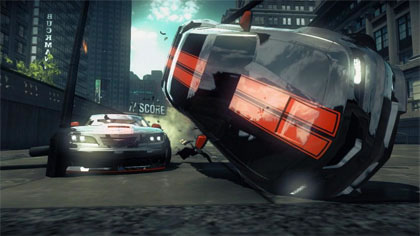
First things first: Unbounded is not your typical Ridge Racer game. It doesn't look like Ridge Racer, it doesn't control like Ridge Racer and it most certainly doesn't sound like Ridge Racer. Instead this is something more akin to Burnout, Split/Second and recent Need for Speed games. Don't let the radical departure scare you off, because Unbounded has enough compelling ideas to make you completely forget about Namco's past failures at updating the Ridge Racer name.
Much like Burnout and Bugbear's own Flat Out series, Unbounded is all about running the competition off the road, finding hidden shortcuts and generally being a jerk driver. You can frag other cars, blow-up overturned tanker trucks, crash through buildings and just about anything else you can think of to come in first. All along the way you earn points, which go towards unlocking cars, race tracks and even other parts of Shatter Bay.
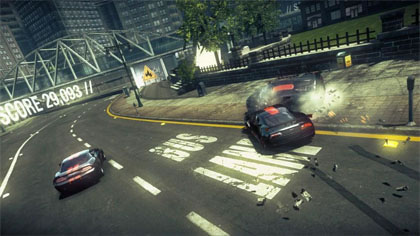
The gimmick here is the way the city crumbles around you. The power meter is more than just another name for a nitro boost; it will allow you to interact with the city in ways that can give you the upper hand. Once the power meter is full, players will be able to find hidden paths by literally busting through the walls of buildings, stadiums, malls and more. You create your own path, all while everybody else is forced to take the long way around these destructible environments.
The power meter also allows players to blow-up well-placed obstacles, making it even harder for your opponents to catch up. And even if you don't have your power meter completely full, there are still all sorts of medians and pillars to crash through. In fact, half of the fun of Unbounded is seeing all of the pieces of debris fly through the air as you crash through brick walls as you take an especially harrowing corner. In most racing games you would be able to bounce off of these walls, but not here. The level of destruction makes for a great first impression.
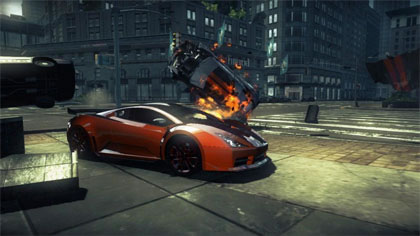
Once you get over seeing the environments crumble at your car's power, you'll notice the creative heads-up display. Instead of simply popping up text telling you how many laps are left or how far behind first place you are, Unbounded seems to project those figures onto the walls and buildings. This may not sound like much, but it gives the game a great sense of style. Even when the game is plowing familiar ground, it's these little touches that set it apart.
Racing is split into a few different varieties, all of which you've already seen in one form or another. The basic race is called Domination and features all of the building crashing and tanker explosions that you've heard about. On the other hand, the Shindo races have you driving fast cars with only a boost meter, forcing you to avoid shortcuts and all-out combat.
Much like Burnout, there's a Frag Attack mode. This is little more than destroying as many cars as possible in a short amount of time. You do this using everything from your standard vehicle to 18-wheelers to cop cars. There's also a Time Attack mode, which forces players to avoid complex obstacles in order to make it to the finish line in time. This mode feels a lot like a polished version of Trackmania, only without the crazy Russian techno. The final mode is a Drift Challenge, but the less said about that the better.
Even people that hate racing games know that Ridge Racer's one defining gameplay mechanic involved a lot of unrealistic drifting. While Unbounded still allows for drifting, it feels nothing like past Ridge Racer games. The cars in this game feel a lot heavier, which means that you'll have to coddle them as they drift around corners. If you don't do it just right, you'll find your car spinning in circles. It takes some getting used to, especially if you're somebody who came into this expecting an old fashioned Ridge Racer experience.
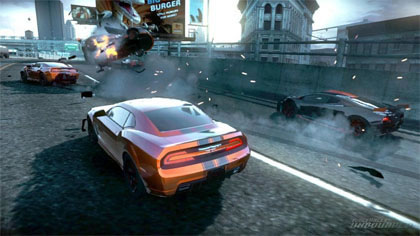
As you progress through Shatter Bay's nine districts, you'll earn brand new tiles that can be used to create custom courses. These are the tiles used in the game's single-player campaign, so you'll end up seeing some of the same obstacles and backgrounds repeated in countless events. As you play through the game you'll start to see how everything is sewn together, which ultimately makes the city less memorable than Burnout's Paradise City or Hot Pursuit's Seacrest County.
Also frustrating is how similar everything looks in Shatter Bay. The dark tone and urban environments stick with the game from start to finish. There's never a moment where you're racing in the hills or next to a large lake, it's always through city streets and passing large skyscrapers. Part of the reason for this is the mix-and-match style levels, but even then there should be a lot more variety in Ridge Racer Unbounded.
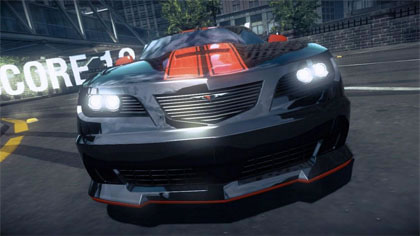
I also have a few complaints about the various modes, none of which are especially creative or original. A lot of early races are marred by unpredictable car accidents. There are too many times where I tried to ram a car off the street only to find myself fragged. Worse yet, I found myself crashing for no reason early on. It's not that I would hit a wall, but rather somebody randomly smacking my car in the final seconds of a race. These complaints aren't exclusive to Ridge Racer Unbounded, but I definitely felt like I saw them more here than in other racing games.
It's also worth mentioning that the Frag Attack doesn't always work the way it's supposed to. For one thing, players will need to manually skip the lengthy animation if they actually want to smash up 25 cars and get first. But the real problem is when you hit a car multiple times without destroying it. Sometimes all it takes is sideswiping an opponent, other times it requires multiple direct hits. There's neither rhyme nor reason to the way the AI takes damage, which can be especially annoying when time is tight. You'll know whether or not you have to restart the entire event within the first 15 seconds.

Those minor gripes aside, I had a great time playing Shatter Bay both online and off. The game has a rich multiplayer mode and tons of high-quality downloadable cities to explore. It's even fun creating your own courses, even if there are a few hiccups along the way. The game's visuals are sharp and full of detail, regardless of how many times you've see the same tile reused. Unfortunately I found the music selection annoying at best, but that isn't an issue when you can add your own custom soundtrack.
Ridge Racer Unbounded is a great new direction for the long-running franchise. It's not what die hard Ridge Racer fans have been asking for, but that shouldn't keep you away from experiencing a solid (albeit unoriginal) action/racing game. There's enough content to keep players coming back for months, making this a strong value despite its flaws.
HOME |
CONTACT |
NOW HIRING |
WHAT IS DEFUNCT GAMES? |
NINTENDO SWITCH ONLINE |
RETRO-BIT PUBLISHING
Retro-Bit |
Switch Planet |
The Halcyon Show |
Same Name, Different Game |
Dragnix |
Press the Buttons
Game Zone Online | Hardcore Gamer | The Dreamcast Junkyard | Video Game Blogger
Dr Strife | Games For Lunch | Mondo Cool Cast | Boxed Pixels | Sega CD Universe | Gaming Trend
Game Zone Online | Hardcore Gamer | The Dreamcast Junkyard | Video Game Blogger
Dr Strife | Games For Lunch | Mondo Cool Cast | Boxed Pixels | Sega CD Universe | Gaming Trend
Copyright © 2001-2025 Defunct Games
All rights reserved. All trademarks are properties of their respective owners.
All rights reserved. All trademarks are properties of their respective owners.





























